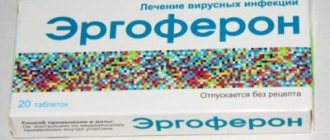Questions, answers, reviews on the drug Ketoprofen VP
You can look at questions about the drug, as well as ask your question to a specialist, using a free consultation with a pharmacist or pharmacist.
The information provided is intended for medical and pharmaceutical professionals. The most accurate information about the drug is contained in the instructions supplied with the packaging by the manufacturer. No information posted on this or any other page of our website can serve as a substitute for personal contact with a specialist.
| * | Our site does not sell medicines and other goods; they must be purchased in pharmacies, in accordance with current laws. Data on prices and availability in pharmacies is updated twice a day. Current prices can always be seen in the section Searching and ordering medications in pharmacies. |
pharmachologic effect
Ketoprofen has anti-inflammatory, analgesic, antipyretic properties, and also inhibits platelet aggregation.
The therapeutic effect of Ketoprofen is due to its ability to inhibit the synthesis of the enzyme involved in the synthesis of prostaglandins and reduce the biosynthesis of prostaglandins themselves, which are responsible for the appearance of edema and pain at the site of inflammation. The use of Ketoprofen can relieve pain in the joints when at rest and in motion, reduce morning swelling and stiffness of the joints, and increase the range of motion.
The anti-inflammatory effect of Ketoprofen can be observed by the end of the first week of treatment. The maximum concentration of the drug in the blood is achieved 15-30 minutes after using Ketoprofen by injection, 1-4 hours after the administration of rectal suppositories and 1-2 hours after oral administration. Ketoprofen is excreted mainly by the kidneys and about 1% by the intestines.
Side effects
Suppositories, Ketoprofen tablets, as well as other forms of the drug, intended for oral and parenteral use, can cause such undesirable reactions of the body as:
- abdominal pain, flatulence, heartburn, vomiting, nausea, diarrhea, decreased appetite, impaired liver function, stomatitis;
- dizziness, nervousness, agitation, depression, drowsiness, headache, confusion;
- blurred vision, tinnitus, hearing loss, eye pain, conjunctivitis;
- increased blood pressure, tachycardia;
- leukopenia (decrease in the level of white blood cells), anemia (reduced level of red blood cells or hemoglobin), thrombocytopenia (decrease in the number of platelets), agranulocytosis (disappearance of granulocytes from the blood);
- edema syndrome (accumulation of excess fluid in the body), urethritis (inflammation of the urethra), cystitis (inflammation of the bladder), nephrotic syndrome (kidney disease, which is characterized by the excretion of large amounts of protein in the urine), impaired renal function;
- skin itching, skin rash, rhinitis, bronchospasm, angioedema;
- increased sweating, nosebleeds, hemoptysis, thirst, shortness of breath.
With prolonged use, Ketoprofen can provoke ulceration of the mucous membrane of the digestive tract, gastrointestinal, vaginal, hemorrhoidal, and gingival bleeding.
Ketoprofen gel and ointment can cause skin hyperemia (large red spots on the skin), purpura (skin coloring as a result of the release of red blood cells from the capillaries), skin rash, photosensitivity (sensitivity to ultraviolet rays), itching, burning, and other allergic reactions.
Ketoprofen
CAS number:
22071-15-4
Gross formula:
C16H14O3
Appearance:
is a white, odorless crystalline substance
Chemical name and synonyms:
Ketoprofen, 2-(3-Benzoylphenyl)propionic acid;
2-(meta-Benzoylphenyl) propionic acid; Alrheumat. Physico-chemical properties:
Molecular weight 254.28 g/mol Melting point 93-96 ° C Solubility: Ketoprofen is easily soluble in diethyl ether and acetone. Practically insoluble in cold water. Easily soluble in ethanol and dichloromethane, chloroform. Soluble in benzene and strong alkali. Also soluble in methanol. Chemical stability: Ketoprofen substance is stable under recommended storage conditions. Keep container tightly closed in a dry and well-ventilated place. Dangerous decomposition products formed under combustion conditions are carbon monoxide.
Description:
Ketoprofen is an anti-inflammatory non-steroidal agent used in humane medicine, as well as in veterinary medicine for the treatment of horses, dogs and cats.
The action of ketoprofen, like other non-steroidal anti-inflammatory drugs, is aimed at relieving pain, inflammation and lowering body temperature during hyperemia, which is due to the mechanism of inhibiting the catalysis of cyclooxygenase oxidation of arachidonic acid to prostaglandin precursors (endoperoxides), suppressing the synthesis of prostaglandins themselves in tissues.
Ketoprofen has two enantiomers, S (+), associated with antiprostaglandin activity, and an R enantiomer (-), which affects analgesia.
In the body, the drug is quickly and almost completely absorbed when administered orally and parenterally, binds 99% (in horses approximately 93%) to blood plasma proteins and penetrates into the synovial fluid. It begins to show its effect 2 hours after administration, reaching its peak effect on the body after 12 hours. It is excreted by the kidneys both unchanged and in the form of a bound metabolite.
Ketoprofen has found its wide application in veterinary medicine. It is most often prescribed for musculoskeletal pain, soft tissue injuries, osteoarthritis, or other problems with bones and joints. This may be due to the reduction or control of fever due to viral or bacterial infections. NSAIDs act by suppressing the body's production of prostaglandins, thromboxanes and other inflammatory mediators. Some of these actions are dose dependent. Ketoprofen can be administered orally. After oral administration, pain relief and fever usually begin within one to two hours. Ketoprofen is also used in dogs and cats for the short-term treatment of post-operative pain. It may sometimes be used for long-term treatment of chronic pain, especially due to osteoarthritis. About 20% of adult dogs are affected by this condition, making treatment of musculoskeletal pain a major component of pet practice. NSAIDs are used more often (etodolac and Rimadyl®). Drugs that protect the gastrointestinal tract, such as misoprostol, cimetidine, omeprazole, ranitidine or sucralfate, are often included in NSAIDs. In horses, ketoprofen is commonly used to control musculoskeletal pain due to soft tissue injury, synovitis and osteoarthritis. It is also used as an antipyretic. Ketoprofen can also be used in the treatment of colic to protect against bacterial toxins (endotoxemia).
Injectable ketoprofen is intended for short-term use only. It is recommended to use it for a maximum of five days. Although ketoprofen for intravenous and intramuscular administration is also often used.
Application:
Ketoprofen is used to relieve inflammation and analgesia for musculoskeletal disorders. Also used as an antipyretic.
The main side effect observed after ketoprofen therapy is the formation of ulcers in the gastrointestinal tract. Since the drug is a non-selective cyclooxyginase (COX) inhibitor, the effect of both COX-2 and COX-1 is suppressed with a high risk of side effects from the gastrointestinal tract.
The dosage and duration of use of ketoprofen is determined by the doctor depending on the reason that led to the need to use the drug. It is widely used after surgery, in the event of post-traumatic inflammation of the musculoskeletal system to relieve pain, for the treatment of arthritis and arthrosis, and as an antipyretic.
Receipt:
The method for producing ketoprofen is carried out by reacting aniline with alpha-halogenated propionic acid halide, benzylation of 3-methyl-2-indolinone, alkaline hydrolysis of 5-benzyl-3-methyl-2-indolinone, deamination of 2-(3-benzyl-6-aminophenyl) propionic acid and oxidation of 2-(3-benzylphenyl)propionic acid.
Or it is carried out in another way, where m-bromobenzoic acid and benzene are used as starting materials, and ketoprofen is obtained through the stages of acylation, protection of the carbonyl group, taking the Grignard reagent, interaction with propylene oxide, oxidation, deprotection, and the like.
Effect on the body:
Ketoprofen (ATC code M01AE03) is a non-steroidal antirheumatic drug derived from propionic acid.
The drug exhibits anti-inflammatory, analgesic and antipyretic effects. The mechanism of action is associated with inhibition of cyclooxygenase (COX), which leads to a decrease in prostaglandin (for example, prostaglandin E2 and prostaglandin F2α). Since prostaglandins are mediators of pain, inflammation and platelet aggregation, as well as gastric protectors and regulators of renal perfusion, most of the clinical effects of ketoprofen can be adequately explained by a decrease in prostaglandin formation. Ketoprofen, like most classical NSAIDs, does not show pronounced selectivity for COX-1 and COX-2.
Currently, medications containing ketoprofen in gel are approved in many European countries.
Studies were conducted to determine the pharmacokinetics of ketoprofen after its intravenous and intramuscular administration in six calves of the Kankray breed. The drug was administered at a dose of 3.0 mg/kg body weight and analyzed in plasma by HPLC. The present study revealed the safety of ketoprofen (3.0 mg/kg) after repeated administration at 24-hour intervals for 5 days in calves.
After intravenous and intramuscular administration of ketoprofen, total body clearance (ClB), area under the influence of plasma drug concentration, half-life values (t1/2b), volume of drug delivery at steady state curve (AUC) and mean residence time (MRT) were 1. 58 ± 0.05 and 3.67 ± 0.14 h; 0.31 ± 0.02 and 0.49 ± 0.03 lkg-1; 3.29 ± 0.14 and 1.74 ± 0.11 ml.min-1 kg-1; 14.91 ± 0.69 and 29.12 ± 1.64 μg.h.ml-1 and 1.48 ± 0.11 and 4.70 ± 0.26 h, respectively. After intramuscular administration, a maximum plasma concentration (Cmax) of 7.55 ± 0.46 μg/ml was achieved after 0.50 hours (Tmax). The systemic bioavailability of ketoprofen after intramuscular administration in calves was 83.50%. The longer half-life, widespread volume of distribution at steady state and slower clearance of ketoprofen after intramuscular administration compared to intravenous administration make it more suitable for intramuscular use in Kankray calves.
Repeated intravenous administration of ketoprofen (3.0 mg/kg body weight, repeated at 24-hour intervals for 5 days) in Kankray calves was found to be safe based on hematological assessment (hemoglobin, packed cell volume, total leukocyte count and differential white blood cell count) and blood biochemical parameters (serum alkaline phosphatase, serum acid phosphatase, serum aspartate aminotransferase, serum alanine aminotransferase, serum lactate dehydrogenase, total bilirubin, serum creatinine, blood urea nitrogen, total serum protein, serum albumin and blood glucose). The present study shows that intramuscular administration of ketoprofen at a dose of 3.0 mg/kg in Kankray calves would provide satisfactory plasma drug concentrations equal to its mean effective concentration up to 18 hours. Therefore, ketoprofen is administered intramuscularly at a dose of 3.0 mg/kg body weight, repeated every 18 hours.
Toxicological data:
LD50 oral 62.4 mg/kg(rat)
Oral LD50 360 mg/kg (mouse).
LD50 for oral administration: 1300 mg/kg (guinea pig).
Too large doses of ketoprofen cause symptoms that include drowsiness, abdominal pain, vomiting, low blood pressure and bronchoconstrictor insufficiency.
Typically, gastric lavage is used to overcome intoxication. Gastrointestinal toxicity, which can lead to hemorrhage, ulceration and perforation, is sometimes fatal. This can be seen at any time during therapy with or without prior symptoms. Risk factors for this disease include age (if the subject is over sixty years of age) and concomitant medications that may affect blood clotting. Non-Hodgkin's lymphoma, as many studies have linked NSAID use to a higher risk of developing this type of cancer. Pregnancy. Due to inhibition of prostaglandin synthesis, ketoprofen can negatively affect pregnancy itself and embryonic development. Some studies suggest a higher risk of miscarriage and heart defects after using ketoprofen in the early stages of pregnancy. In fact, its use can expose the unborn child to cardiovascular, pulmonary (premature blood pressure and high blood pressure closure) diseases and kidney damage.
Contraindications
According to the instructions, Ketoprofen is not prescribed for:
- severe liver or kidney dysfunction;
- peptic ulcer in the acute phase;
- inflammatory bowel diseases;
- blood clotting disorders;
- hypersensitivity to ketoprofen or other non-steroidal anti-inflammatory drugs.
Ketoprofen is contraindicated for use in the third trimester of pregnancy, during breastfeeding, and for children under 14 years of age.
Ketoprofen suppositories are not prescribed for proctitis (inflammation of the mucous membrane of the sigmoid and rectum) and proctorragia (bleeding from the anus).
Ketoprofen ointment should not be used for eczema (skin rash), weeping dermatoses and infected wounds.
The instructions recommend using Ketoprofen with caution in case of bronchial asthma, anemia, liver failure, alcoholism, sepsis, edema, chronic heart failure, stomatitis, arterial hypertension, diabetes mellitus, and a history of ulcerative lesions of the digestive tract. The use of Ketoprofen in the first and second trimester of pregnancy is possible only under strict indications.
Adverse reactions
Although the composition of Ketoprofen tablets does not contain any harmful substances that could cause negative consequences, side effects sometimes occur in patients:
- Most often, adverse symptoms associated with effects on the gastrointestinal tract occur. These include flatulence, bloating, nausea and vomiting, and diarrhea. Often the patient loses his appetite.
- The mucous membranes of the oral cavity can be affected by stomatitis.
- Problems often arise with the nervous system. The patient may feel dizzy, excessive nervous excitement, or, conversely, passivity to everything that is happening. Such a person quickly gets tired and feels drowsy, although he still cannot fall asleep.
- Problems also arise with the olfactory organs. A person taking Ketoprofen may complain of impaired visual perception (blurredness and blurriness). Conjunctivitis often appears on the mucous membranes of the eye. The hearing organs may also be affected: ringing in the ears or a person hears noises of unknown origin.
- Taking the drug may also affect the functioning of the heart. High blood pressure or tachycardia may indicate that it is time to stop taking the active substance.
- A number of other side effects were recorded: tearing, nosebleeds, excessive sweating, itchy skin, rashes, thirst and shortness of breath. And this is not the entire list.
These side effects may be caused or aggravated by drug interactions between Ketoprofen and other drugs. That is why, before using a substance, you should inform a specialist about the drugs that you use together with it.
How to use the product
Instructions for use of Ketoprofen are provided in the packaging for each form of the drug.
The choice of a specific form is determined taking into account the individual characteristics of the patient.
All drugs that are released for oral administration can be combined with each other. They are produced in the form of capsules, granules, dragees, etc.
Experts recommend taking tablets and other oral medications with meals. Usually the active substance is taken 3 times a day, the dose is 100 mg. Extended-release tablets should be taken 2 times a day, 150 mg. If the doctor prescribed capsules, then you should drink 50 mg of the drug in the morning and afternoon, and 100 mg in the evening.
Granules are usually used 3 times a day, 1 sachet. Each of them contains 80 mg of active substance. A single dose for children under 18 years of age and elderly people (60 years of age and older) is 1/2 sachet. Before use, the contents should be dissolved in half a glass of warm water.
Before starting treatment with this drug, you should consult a specialist. Taking the drug for longer than 2 weeks is strictly prohibited. Only a doctor can adjust or prescribe an additional course.
Indications for use of Ketoprofen
The instructions recommend prescribing Ketoprofen for:
- symptomatic treatment of chronic inflammation of the joints (arthritis): rheumatoid polyarthritis (destruction of bone, articular cartilage), psoriatic arthritis (inflammation of the joints due to psoriasis), ankylosing spondylitis (disease of the spine), gout (a disease of the joints in which uric acid salts are deposited in the tissues) , arthrosis with pain syndrome;
- symptomatic treatment of diseases of the musculoskeletal system that are inflammatory and degenerative in nature: tendinitis (inflammation of the tendon tissue), tenosynovitis (inflammation of the protective membrane around the tendon), lumbago (acute lower back pain), bursitis (inflammation of the mucous bursae in the joint area);
- symptomatic short-term treatment of acute pain syndrome: neuralgia, spinal pain, muscle pain;
- complex therapy of inflammatory diseases of the lymph nodes, lymphatic vessels, veins: lymphangitis (inflammation of the lymphatic vessels), superficial lymphadenitis (inflammation of the lymph nodes), periphlebitis (inflammation of the perivenous tissue and veins), phlebitis (inflammation of the vein wall).
Ketoprofen gel is used for uncomplicated sports injuries, ruptures or sprains of tendons and ligaments, bruises of ligaments and muscles, post-traumatic swelling and pain.





